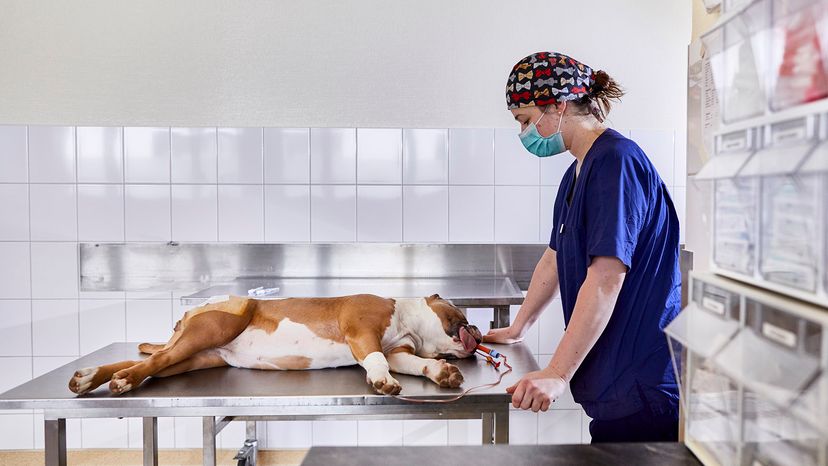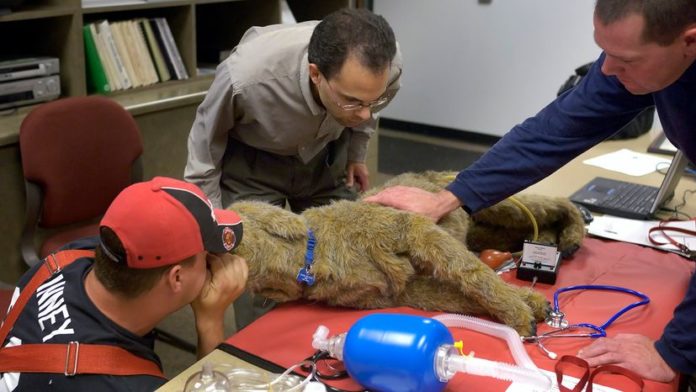 “Veterinarian Dr. Mike Estrin (center) instructs two New Brighton, Minnesota, firefighters on how to give a dog CPR using a CPR-practice dog. One simulates mouth-to-snout breathing while the other feels for lungs filling with air. Star Tribune via Getty Images/Getty Images
“Veterinarian Dr. Mike Estrin (center) instructs two New Brighton, Minnesota, firefighters on how to give a dog CPR using a CPR-practice dog. One simulates mouth-to-snout breathing while the other feels for lungs filling with air. Star Tribune via Getty Images/Getty Images
It was my worst nightmare: My beloved 13-year-old English bulldog, Ellie, collapsed one morning after our regular walk. She did her business as usual, but on our way back, she stopped at the welcome mat and fainted. It took what seemed like an eternity for her to come out of a daze.
When she did regain consciousness, she was wheezing and having difficulty breathing. That’s when I instinctively flew into life-saving mode.
Although I had no idea how to perform cardio pulmonary resuscitation (CPR) on a dog, I had seen it performed on humans and so I began pressing her chest, slapping her face and even giving her mouth to mouth the best I could. Then I put her in the car and raced to the vet where they immediately gave her oxygen and an IV. The next day my vet told me that my actions had "saved her bacon."
Since then, Ellie’s been diagnosed with a disease that can sometimes make her heart stop beating. So I vowed to learn the correct way to perform CPR on a dog, just in case this happens again. Here’s what I found out from several experts on the subject.
How to Know When Your Dog Needs CPR
Dr. Rebecca Greenstein, a veterinary medical adviser for Rover.com and chief veterinarian of Ontario’s Kleinburg Veterinary Hospital, says you should seek immediate veterinary attention and begin CPR efforts if your pet is showing any of the following signs:
- They’re unresponsive or unconscious
- They’re not breathing (you can’t see their chest rising or falling or moving at all)
- You don’t feel a pulse or heartbeat. (You’ll feel it on the left side of their chest, close to where their flexed elbow would meet their chest wall.)
"The goal," says Dr. Travis Arndt, director of the Animal Medical Center of Mid-America in St. Louis, Missouri, "is to maintain oxygen flow to the vital organs until the heartbeat and breathing is reestablished."
How to Perform CPR on Your Dog
"Basic CPR is as easy as A-B-C: Airway-Breathing-Circulation," Greenstein explains. She also notes that, in cases where where a dog has gone into cardiac arrest (rather than one that is known to have heart disease), it might be advisable to begin chest compressions first. But the typical A-B-C order is OK, as long as you start all components of CPR fairly quickly, and if no other options or resources are available.
She breaks down the steps she uses to perform CPR on a dog:
A: Airway
- Lie your dog on his right side so the left side of his body is facing up.
- Make sure the surface underneath is firm and free of any hazards and debris.
- Use your index finger to clear the back of the throat of any foreign body or fluid that could choke his airway. (Do not overextend his neck.)
- Pull the dog’s tongue forward to his front teeth so it doesn’t fold back into his throat and block his airway.
B: Breathing
- If your dog isn’t breathing, close his mouth and breathe into his nostrils to try to inflate his lungs (mouth-to-snout breathing technique).
- Exhale into the nostrils forcefully enough to see his chest rise.
- Let your dog exhale the breath passively before breathing into the nostrils again.
- Typically aim for 10 breaths per minute, or if you’re doing it concurrently with chest compressions, do two breaths after every 30 chest compressions.
C: Compressions
- Chest compressions are meant to simulate a heartbeat, to help the dog’s blood pump around the body when the heart has stopped.
- When performing chest compressions on a dog lying on his side, compress the chest by no more than one-third to one-half of the depth of the chest.
- Current guidelines recommend 100-120 chest compressions per minute. While this might not sound like a lot, this amount can physically exhaust you.
Does Your Dog’s Size Matter?
While mouth-to-snout breathing support is similar regardless of the size of your pet, size does matter in how you perform chest compressions.
For medium and large dogs: Chest compressions should be administered with the dog on his side. Press down (with one hand on top of the other, palms down) over the widest part of the dog’s chest.
In smaller dogs: You should use a circumferential method on smaller dogs. This means you place your hands around completely around the dog’s chest and back, letting your thumbs meet at the dog’s sternum (the lowest past of the chest where the ribs meet).
For barrel-chested dogs: Barrel-chested dogs (such as English bulldog, Great Danes, Saint Bernards or basset hounds) should be placed on their backs and you should use both hands to perform compressions on the front of the chest (instead of the side). The reason? It’s farther to the dog’s heart, and more difficult to perform effective compressions, if you place these dogs on their sides.
How Effective Is Dog CPR?
The effectiveness of dog CPR varies, but in general, less than 10 percent of patients will survive the efforts, Greenstein says. Dogs arresting from anesthetic-related causes have a much higher chance of survival, and the faster an arrest is recognized and CPR initiated, the more likely there will be a positive outcome.
"About 35 percent of pets that experience cardiac or respiratory arrest, and then return to spontaneous breathing, will have another episode of arresting," Arndt adds. "It is reported that around 60 percent of patients that arrest fail to be resuscitated or are euthanized due to the severity of their illness."
Why do so few pets seem to survive? One answer might lie in case selection, with most dogs receiving CPR just too sick or injured to survive because they often are in severe shock.
Some good news? During her 20 years of teaching CPR classes, Fleck says she has heard back from dozens of students who have successfully performed doggy or kitty CPR.
Are There Risks to the Dog?
"If you need to perform CPR, the pet is theoretically ‘dead,’ so really, the only risk is not in trying to do something that could resuscitate your precious best friend," Fleck says. Although if you give CPR outside of a veterinary hospital you should be aware of what could happen. For example, overzealous chest compressions can cause rib fractures, lung bruises or lacerations, air in the chest and collapsed lungs. Other often-overlooked risks include tracheal bleeding, and ineffective CPR efforts and unnecessary delays in seeking professional medical help.
"The biggest concern I hear from students is about breaking a rib," Fleck says. "Dogs have more flexible ribs than humans, so when done properly, chances are very low (less than 1.6 percent) of a rib fracture. In small animals, you certainly want to be careful to give smaller ‘puff’ breaths, so as not to over-inflate the lungs, which could prevent recovery."
 “Even if you’re able to resuscitate your dog, you should still take him to the vet immediately. Your veterinarian is well-equipped in case your dog crashes again.Oliver Rossi/Getty Images
“Even if you’re able to resuscitate your dog, you should still take him to the vet immediately. Your veterinarian is well-equipped in case your dog crashes again.Oliver Rossi/Getty Images
What Do I Do After CPR?
In the case of a human who’s receiving CPR, someone almost always calls 911 and paramedics arrive to take over. "Not so with our furry best friends," says Denise Fleck, who founded Sunny-dog Ink (aka the Pet Safety Crusader) in 1999 to teach animal life-saving skills. "We must treat without medications and do the transportation ourselves in most cases." Translation? Take them to the vet, STAT.
Dr. Sara Ochoa, a veterinary consultant for DogLab.com, agrees. "If you are successful at reviving your dog, they should go to the veterinarian right away. They can always crash again and need more CPR. Your veterinarian is well-versed in CPR and has more capabilities for life support at their clinic than you do at home."
Dr. Jennifer Coates, an advisory board member of Pet Life Today also agrees. "Even when CPR is initially successful, it is not unusual for a dog to quickly experience cardiopulmonary arrest again. Additional treatment and diagnostics will almost always be necessary."
Lastly, Greenstein cautions that advanced CPR efforts can only be performed by a large skilled veterinary medical team, and may mean the difference between life or death.
NOW THAT’S Awesome
Greenstein recommends every dog owner take a course in small animal CPR, as well as talk to their family vet about the steps to take in an emergency. The American Red Cross offers CPR classes for dogs and cats. It’s part of the Cat and Dog First Aid course, which can help prepare you to deliver first aid care for your pets.








































